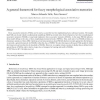Free Online Productivity Tools
i2Speak
i2Symbol
i2OCR
iTex2Img
iWeb2Print
iWeb2Shot
i2Type
iPdf2Split
iPdf2Merge
i2Bopomofo
i2Arabic
i2Style
i2Image
i2PDF
iLatex2Rtf
Sci2ools
FSS
2008
2008
A general framework for fuzzy morphological associative memories
Fuzzy associative memories (FAMs) can be used as a powerful tool for implementing fuzzy rule-based systems. The insight that FAMs are closely related to mathematical morphology (MM) has recently led to the development of new fuzzy morphological associative memories (FMAMs), in particular implicative fuzzy associative memories (IFAMs). As the name FMAM indicates, these models belong to the class of fuzzy morphological neural networks (FMNNs). Thus, each node of an FMAM performs an elementary operation of fuzzy MM. Clarifying several misconceptions about FMAMs that have recently appeared in the literature, we provide a general framework for FMAMs within the class of FMNN. We show that many well-known FAM models fit within this framework and can therefore be classified as FMAMs. Moreover, we employ certain concepts of duality that are defined in the general theory of MM in order to derive a large class of strategies for learning and recall in FMAMs.
| Added | 10 Dec 2010 |
| Updated | 10 Dec 2010 |
| Type | Journal |
| Year | 2008 |
| Where | FSS |
| Authors | Marcos Eduardo Valle, Peter Sussner |
Comments (0)

